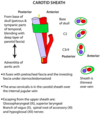Spine Flashcards
(105 cards)
the occiput-c1 (Atlas) joint provides most of what ROM? How much?
flexion/extension. 50%
c1-c2 joint (Axis) provides most of what ROM? how much?
Rotation. 50%
surface land marks:
C2-3
C3
C4-5
C2-3: mandible
C3: hyoid
C4-5: thyroid cartilage
surface landmarks:
C6
C7
T3
C6: cricoid cartilage
C7: vertebral prominens
T3: scapular spine
surface landmarks:
T4
T7
L2
L4
L4-5
T4: nipples (variable)
T7: distal tip of scapula
L2: Renal Arteries
L4: Aortic Bifurcation
L4-5: iliac crest (L4 spinous process is at the level of the iliac crest)
what spinal vertebrae have bifid spinous processes?
C2-6
At what level is the spinal cord largest in the c-spine?
C2
L-spine vert bodies are what shape?
T Spine?
L spine - kidney
T spine - heart
mamillary processes occur in what spinal region?
from what structure do they project from?
L-spine
from superior articular process
allow for attachment of the multifidis muscles.

How many sacral foramina are there?
4 pairs dorsal and ventral
The dorsal and ventral primary rami exit respectively

how many vertebrae fused embryologically to form the coccyx?
usually 4 sometimes 5
most common site of disc herniation?
second most common?
L5/S1 first, L4/5 second
What is the Tectorial membrane?
the extension of the PLL from C1 to the skull
Where does the transverse ligament of the c-spine live?
Posterior to Dens, stabilizes a-a joint and keeps dens up against anterior arch of c1
Part of the cruciate ligament which lies anterior to the tectorial membrane, behind the odontoid process
- The transverse atlantal ligament is the strongest component, connecting the posterior odontoid to the anterior atlas arch, inserting laterally on bony tubercles
- Vertical bands extend from the transverse ligament to the foramen magnum and body of the axis.

What is the Anterior Atlanto-Occipital membrane?
an extension of the ALL from C1 to the skull.
alar ligaments joint what to what?
embryologically they are remnants of what?
from occiput to tip of dens
remnant of notochord

cruciform ligament of atlas is made of what?
includes the transverse ligament
plus inferior and superior longitudinal bands

What are the two layers of the intervertebral discs and which layer contains nerve endings?
annulus fibrosis and nucleus pulposus
The AF contains nerve fibers.
What type of fibers compose the annulus fibrosis and how are they oriented?
type I collagen fibers oriented obliquely.
nucleus pulposis is mostly what collagen type?
type II
What is the orientation of the facet joints as your progress down the spine?
Sagittal Coronal
C 45° 0°
T 60° 20°
L 90° 45°

Describe the amount of pedicle screw “intoeing” you need as you go from T1-L5
Thoracic spine:
DECREASES at you go down from T1-T12
In males, goes from ~40 deg to ~15 deg
Therefore greatest at T1
Lumbar spine:
INCREASES as you go down from L1-L5
L1 approximately 5-10 deg
increases ~5 deg per level from L1 down to sacrum

What are the landmarks for the T-spine pedicle screw start point?
Superior ridge of TP
Midpoint of inferior articular facet

What is the landmarks for a lumbar pedicle screw start point?
midpoint of TP
midpoint of superior articular process
nb: pars lines up with medial aspect of pedicle











































